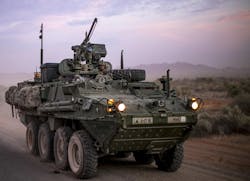Army asks General Dynamics to build Stryker armored combat vehicles with industry-standard VICTORY vetronics
WARREN, Mich. – Armored combat vehicles designers at General Dynamics Corp. will build advanced Stryker wheeled vehicles for the U.S. Army under terms of a $146.7 million contract announced Thursday.
Officials of the Army Contracting Command-Detroit Arsenal in Warren, Mich., are asking General Dynamics Land Systems in Sterling Heights, Mich., to build flat-bottom-hull Stryker vehicles.
Stryker is a deployable fighting vehicle that is more lethal than light vehicles like Humvees, yet is lighter and more maneuverable than heavyweight combat vehicles like the M1 Abrams main battle tank.
Most Stryker vehicles and vetronics today have the Protector M151 Remote Weapon Station with .50-cal M2 machine gun, 7.62 mm M240 machine gun, or Mk-19 automatic grenade launcher. Some heavily armed versions have a 105-millimeter main gun, similar to a tank.
Related: Wanted: companies to build vetronics computers for armored combat vehicles
Compared to earlier versions of the Stryker, the upgraded Stryker A1 has superior engine power, which should result in greater mobility in combat.
The flat-bottom Stryker family has three variants on a common vehicle platform: the M1127 Reconnaissance Vehicle, the M1128 Mobile Gun System, and the M1135 NBC Reconnaissance Vehicle.
The Stryker A1 also can be equipped with a scout mission equipment package modification for reconnaissance missions.
The Stryker A1 also establishes the framework for the Vehicular Integration for C4ISR/EW Interoperability (VICTORY) vetronics industry-standard architecture for networking integration and data sharing among the vehicle's common crew stations. The new Stryker version also provides Gigabit Ethernet capability.
The Stryker A1 has a 910-amp alternator to support future electrical power upgrades for future network equipment; an enhanced power distribution unit chassis upgrade; increased chassis payload capacity from 55,000 pounds to 63,000 pounds; and upgrades to its driveline to support an in-vehicle network architecture.
Addition of 30-millimeter cannon turret to the Stryker can boost the vehicle's firepower substantially. A 30-millimeter cannon bullet is about 10 inches long, while a .50 caliber machine gun bullet is about five inches long, and a 7.62 millimeter machine gun bullet is about three inches long.
While .50 caliber and 7.62 millimeter machine guns primarily shoot anti-personnel bullets for fighting enemy soldiers, the 30-millimeter cannon is an armor-piercing round that is effective against other armored vehicles and fortified bunkers.
The Stryker armored combat vehicle is named for two American servicemen who posthumously received the Medal of Honor: Private First Class Stuart S. Stryker, who died in World War II, and Specialist Four Robert F. Stryker, who died in the Vietnam War.
On this contract General Dynamics will do the work at locations be determined with each order, and should be finished by November 2024. For more information contact General Dynamics Land Systems online at www.gdls.com, or U.S. Army Contracting Command-Detroit Arsenal at https://acc.army.mil/contractingcenters/acc-dta/.
About the Author
John Keller
Editor-in-Chief
John Keller is the Editor-in-Chief, Military & Aerospace Electronics Magazine--provides extensive coverage and analysis of enabling electronics and optoelectronic technologies in military, space and commercial aviation applications. John has been a member of the Military & Aerospace Electronics staff since 1989 and chief editor since 1995.
